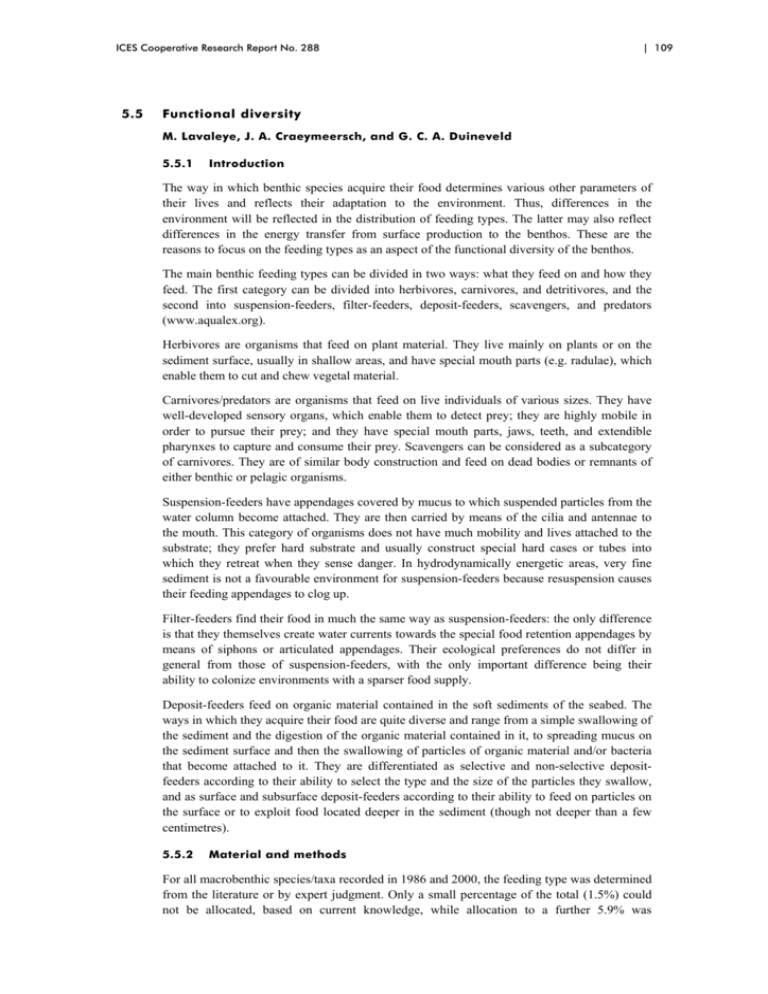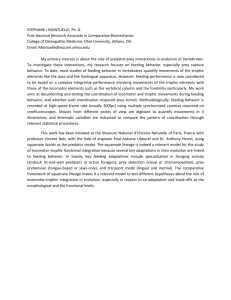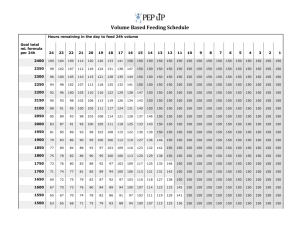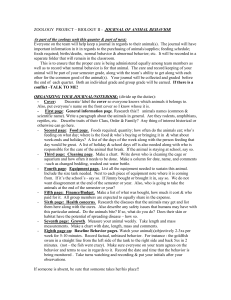advertisement

ICES Cooperative Research Report No. 288 5.5 | 109 Functional diversity M. Lavaleye, J. A. Craeymeersch, and G. C. A. Duineveld 5.5.1 Introduction The way in which benthic species acquire their food determines various other parameters of their lives and reflects their adaptation to the environment. Thus, differences in the environment will be reflected in the distribution of feeding types. The latter may also reflect differences in the energy transfer from surface production to the benthos. These are the reasons to focus on the feeding types as an aspect of the functional diversity of the benthos. The main benthic feeding types can be divided in two ways: what they feed on and how they feed. The first category can be divided into herbivores, carnivores, and detritivores, and the second into suspension-feeders, filter-feeders, deposit-feeders, scavengers, and predators (www.aqualex.org). Herbivores are organisms that feed on plant material. They live mainly on plants or on the sediment surface, usually in shallow areas, and have special mouth parts (e.g. radulae), which enable them to cut and chew vegetal material. Carnivores/predators are organisms that feed on live individuals of various sizes. They have well-developed sensory organs, which enable them to detect prey; they are highly mobile in order to pursue their prey; and they have special mouth parts, jaws, teeth, and extendible pharynxes to capture and consume their prey. Scavengers can be considered as a subcategory of carnivores. They are of similar body construction and feed on dead bodies or remnants of either benthic or pelagic organisms. Suspension-feeders have appendages covered by mucus to which suspended particles from the water column become attached. They are then carried by means of the cilia and antennae to the mouth. This category of organisms does not have much mobility and lives attached to the substrate; they prefer hard substrate and usually construct special hard cases or tubes into which they retreat when they sense danger. In hydrodynamically energetic areas, very fine sediment is not a favourable environment for suspension-feeders because resuspension causes their feeding appendages to clog up. Filter-feeders find their food in much the same way as suspension-feeders: the only difference is that they themselves create water currents towards the special food retention appendages by means of siphons or articulated appendages. Their ecological preferences do not differ in general from those of suspension-feeders, with the only important difference being their ability to colonize environments with a sparser food supply. Deposit-feeders feed on organic material contained in the soft sediments of the seabed. The ways in which they acquire their food are quite diverse and range from a simple swallowing of the sediment and the digestion of the organic material contained in it, to spreading mucus on the sediment surface and then the swallowing of particles of organic material and/or bacteria that become attached to it. They are differentiated as selective and non-selective depositfeeders according to their ability to select the type and the size of the particles they swallow, and as surface and subsurface deposit-feeders according to their ability to feed on particles on the surface or to exploit food located deeper in the sediment (though not deeper than a few centimetres). 5.5.2 Material and methods For all macrobenthic species/taxa recorded in 1986 and 2000, the feeding type was determined from the literature or by expert judgment. Only a small percentage of the total (1.5%) could not be allocated, based on current knowledge, while allocation to a further 5.9% was 110 | Structure and dynamics of the North Sea benthos inappropriate owing to taxonomic imprecision (e.g. unidentified bivalves). The feeding types were eventually divided into four main groups (Table 5.5.1). The parasites were put into a separate (fifth) group, but this was very small in terms of density and biomass and is not dealt with further in this account. Table 5.5.1. Feeding groups. FEEDING GROUP DESCRIPTION I Suspension- or filter-feeder II Interface-feeder, surface deposit-feeder, facultative suspension-feeder III Subsurface deposit-feeder, grazer IV Predator, omnivore, scavenger V Parasite na Not appropriate at the recorded taxonomic level U Unknown For the four main feeding guilds, distribution plots were made based on the data of 1986 and 2000 separately. The percentage of each feeding group was plotted for those stations where it exceeded 40% of the total density. For this reason, only two maps are needed to illustrate the distribution of the feeding guilds (Figure 5.5.1 and Figure 5.5.2). The relationship between latitude and percentage of each feeding group was inspected using X-Y scatterplots, further visualized by adding a lowess smoother for both the 1986 and 2000 data. Differences between 1986 and 2000 in the proportion of each feeding group were tested for significance using the following tests: • • • unpaired and paired t-test analysis of similarities (ANOSIM) non-parametric MANOVA (NPMANOVA) For these tests, the data (percentages) were arcsin transformed. Furthermore, for the last two multivariate analyses, the feeding groups were treated as variables, i.e. descriptors of the community. All the analyses were done for the three main areas of the North Sea as delineated by the community analysis of 1986 (TWINSPAN groups I, II, and III, based on species abundances; Künitzer et al., (1992)). 5.5.3 Results The percentage of suspension-feeders is large on the Oyster Ground and (in 2000) in parts of the German Bight (Figure 5.5.1 and Figure 5.5.2). On the Dogger Bank and to the north in the deeper water of the North Sea, filter-feeders form a minority of the macrobenthos. In the shallow part south of the Frisian Front, the percentage of suspension-feeders is also small. This is also the case along the Belgian and French coasts and in the English Channel, though there are some stations with large percentages. (Note that, in the last case, a large number of stations are situated close together). Interface-feeders form the most important part of the infauna over the whole North Sea, except for the Oyster Ground. At many stations, the percentage of this feeding guild is larger than 50%. Subsurface deposit-feeders form a minority in the North Sea. Only in the German Bight, in the Channel, and along the Belgian and French coasts are they found in greater numbers, but not often exceeding 50%. Predators, scavengers, and omnivores together demonstrate a pattern similar to that of subsurface deposit-feeders, though with slightly larger percentages, especially in the coarser sediments along the UK coast. ICES Cooperative Research Report No. 288 | 111 The large proportion of suspension-feeders in the Oyster Ground is also apparent from the latitudinal gradient (Figure 5.5.3). Interface-feeders demonstrate a drop in their proportion in that area. Subsurface feeders fluctuate around a low value, but without obvious peaks or dips. The proportion of predators appears to be similar over the whole latitudinal range, except in the south where there is evidence of an increase. Overall, there was no evidence of a marked change in the proportion of feeding types along the latitudinal gradient in 1986 and 2000, and the lowess lines of both years (1986 and 2000) are quite similar for each feeding guild (Figure 5.5.3). In all three North Sea assemblages (based on Künitzer et al., 1992), there is a difference in the proportion of the feeding groups between 1986 and 2000 (ANOSIM, NPMANOVA: Table 5.5.2). The t-tests reveal that, in assemblage 1, covering the shallowest stations, there is a significant difference between the proportion of interface-feeders and subsurface depositfeeders in 1986 and 2000 (Table 5.5.2). In the somewhat deeper (30–70 m) stations with finer sediments (assemblage 2), 1986 and 2000 differ in the proportion of all feeding groups. In the deeper area (assemblage 3), there is a difference in the proportion of subsurface depositfeeders and carnivores. Table 5.5.2. Differences between 1986 and 2000 in the proportion of each feeding group (I–IV), tested for significance using unpaired and paired t-tests and community analyses (ANOSIM, NPMANOVA). * = significantly different, ** = highly significantly different. ASSEMBLAGE ANALYSIS I 1 unpaired t-test p = 0.305 p = 0.005** p <0.001** p = 0.250 paired t-test p = 0.268 p <0.001** p <0.001** p = 0.120 2 unpaired t-test p = 0.06 p <0.001** p = 0.049* p <0.001** paired t-test p = 0.006* p <0.001** p = 0.018** p <0.001** unpaired t-test p = 0.442 p = 0.648 p = 0.020* p <0.001** paired t-test p = 0.311 p = 0.638 p = 0.008* p <0.001** 3 ASSEMBLAGE 1 2 3 5.5.4 ANALYSIS NPMANOVA II III IV P-VALUE p <0.001** ANOSIM p <0.001** NPMANOVA p = 0.002** ANOSIM p = 0.001** NPMANOVA p = 0.005** ANOSIM p = 0.001** Discussion Surprisingly, in this comparison of the density of the different feeding types between 1986 and 2000, we found a statistically significant difference for the three main faunal assemblages (1−3) in the North Sea, as identified by Künitzer et al. (1992). However, the nature of the changes appears to be different between assemblages, and possible causes are considered below. In assemblage 2, centred on the Oyster Ground at moderate depth (30–70 m) and with a high mud content, all feeding types exhibited change. The Oyster Ground is characterized by a high-density and a high-proportional contribution of suspension-feeders, which is the case for 1986 as well as 2000. This is caused mainly by the brittlestar Amphiura filiformis. From the yearly biomonitoring of the benthos in the Dutch sector covering the Oyster Ground, there is evidence that Amphiura has declined since the 1990s (Daan and Mulder, 2005). There are several possible explanations for this change, including fishing activity, increased resuspension caused by higher windstress, and an ecological “regime shift” as the Amphiura population at the low point of a natural cycle of variation in densities is displaced by larger 112 | Structure and dynamics of the North Sea benthos numbers of Callianassa subterranea and Upogebia deltaura (van Nes et al., 2007). A large change in the Amphiura population can explain not only the difference in the proportion of suspension-feeders, but also of other feeding types because, expressed in this way, they are dependent variables. High densities of suspension-feeders in an area are often seen as an indication of an unpolluted or unstressed environment, and this is reflected in the scoring systems for many marine biotic indices (e.g. Borja et al., 2000; Word, 1978). It follows that a decrease of suspension-feeders would point to increased stress. In assemblage 1, covering mainly the southern part of the North Sea with sandy sediment and shallow depths, there was a significant change in the proportion of the interface-feeders and subsurface feeders. The interface-feeders increased, while the subsurface feeders decreased. For the interface-feeders, these changes were mainly caused by the greater numbers of Spiophanes bombyx and Magelona spp. in 2000. These short-lived polychaetes, however, can demonstrate large year-to-year differences in their populations. This is evident from long-term monitoring of the macrobenthic fauna in the Dutch sector of the North Sea (1990–2005: Daan and Mulder, 2006), and instead of an increase, they note a somewhat decreasing trend in Spiophanes densities. For Magelona spp., they cannot show a clear trend. Scoloplos armiger and Ophelia borealis were responsible for the decrease of subsurface feeders in our comparison between 1986 and 2000. Here the same argument applies as for Spiophanes and Magelona, namely that the changes are probably caused by normal year-to-year variations in the densities of these short-lived species, rather than pointing to a clear long-term trend. In assemblage 3, located in the deeper area of the North Sea, a difference in the proportion of subsurface deposit-feeders and carnivores was found. The subsurface feeders demonstrated a proportional decrease from 1986 to 2000. Among the species causing this change, the Capitellidae had the highest contribution, but no single species could be held responsible for the change. The main species responsible for the increase of carnivores was Paramphinome jeffreysii. As for the changes in assemblage 1, we argue that these are mainly caused by yearto-year fluctuations in the population of short-lived species. We conclude that, based on the proportional contribution of the four feeding guilds, there is a clear change in the central North Sea (Oyster Ground and surroundings), which is backed up by annual monitoring. For the other parts of the North Sea, we noted a change, but could not designate this as a continuous trend over the years. It is unfortunate that these North Sea-wide quantitative exercises cannot be conducted on a more frequent (even annual) basis, because long-term trends can now be difficult to separate from annual fluctuations in the macrobenthic populations. We stress that, in response to increasing concerns over global warming, the possibility of declining fishery effort in the future (because of regulations or stock depletion) and the designation of marine protected areas in the North Sea, it is very important to monitor the consequences for the benthic fauna at appropriate frequencies. After decades of increasing fishing effort and concerns over pollution and other human activities, it is surprising that the first quantitative survey of the macrobenthic fauna of the whole North Sea was only carried out in 1986. Further, it has taken another 15 years to achieve a repeat assessment on a comparable scale. This seems to be an unacceptably low frequency, given the continued importance of the North Sea for mankind and nature. ICES Cooperative Research Report No. 288 | 113 Figure 5.5.1. Distribution of the feeding groups for 1986. The feeding group per station is shown only if larger than 40%. The symbols representing the four different feeding types have different colours as well as different sizes to make a possible overlap visible in the case of two feeding types having more than 40% of the total density at the same station. 114 | Structure and dynamics of the North Sea benthos Figure 5.5.2. Distribution of the feeding groups for 2000. The feeding group per station is shown only if larger than 40%. The symbols representing the four different feeding types have different colours as well as different sizes to make a possible overlap visible in the case of two feeding types having more than 40% of the total density at the same station. ICES Cooperative Research Report No. 288 | 115 Suspension feeders Interface feeders 80 100 data 2000 data 1986 lowess data 1986 lowess data 2000 60 data 1986 data 2000 lowess data 1986 lowess data 2000 80 60 40 40 20 20 0 0 50 52 54 56 58 60 50 Latitude 52 54 56 58 60 Latitude Predators, Omnivores & Scavengers Subsurface deposit feeders 100 100 data 1986 data 2000 lowess data 1986 lowess data 2000 80 80 60 60 40 40 20 20 0 data 1986 data 2000 lowess data 1986 lowess data 2000 0 50 52 54 56 58 Latitude 60 50 52 54 56 58 Latitude Figure 5.5.3. Latitudinal gradients in proportion of feeding groups (the Y axes are % feeding type). The lowess line is a locally weighted regression line used to smooth and visualize fluctuations. References Aqualex. 2007. www.aqualex.org. Borja, A., Franco, J., and Perez, V. 2000. A marine biotic index to establish the ecological quality of soft-bottom benthos within European estuarine and coastal environments. Marine Pollution Bulletin, 40: 1100–1111. Daan, R., and Mulder, M. 2005. The macrobenthic fauna in the Dutch sector of the North Sea in 2004 and a comparison with previous data. Royal Netherlands Institute for Sea Research, NIOZ–RIKZ Rapport 2005–3. 95 pp. Daan, R., and Mulder, M. 2006. The macrobenthic fauna in the Dutch sector of the North Sea in 2005 and a comparison with previous data. Royal Netherlands Institute for Sea Research, NIOZ–RIKZ Rapport 2006–3. 93 pp. Künitzer, A., et al. 1992. The benthic infauna of the North Sea: species distribution and assemblages. ICES Journal of Marine Science, 49(2): 127–143. van Nes, E. H., Amaro, T., Scheffer, M., and Duineveld, G. C. A. 2007. Possible mechanisms for a marine benthic regime shift in the North Sea. Marine Ecology Progress Series, 330: 39–47. Word, J. Q. 1978. The Infaunal Trophic Index, pp. 19–39. Coastal Water Research Project Annual Report. Southern California Coastal Water Research Project, El Segundo, CA. 60



